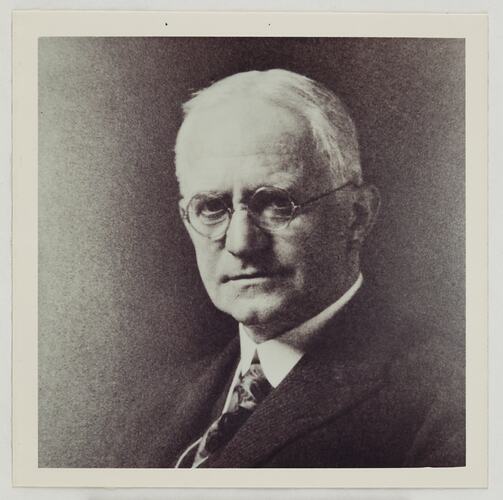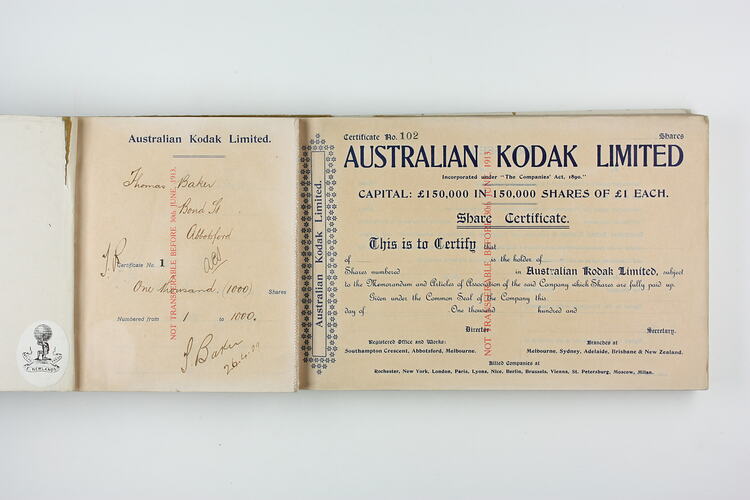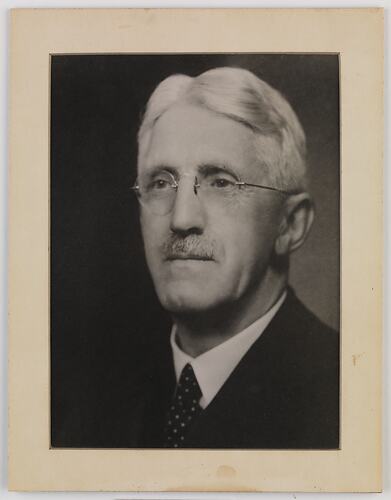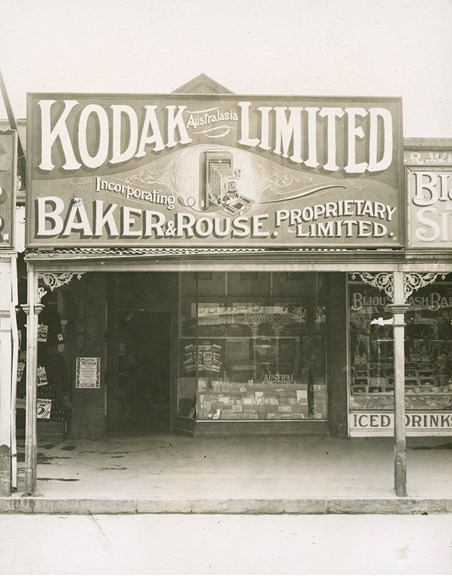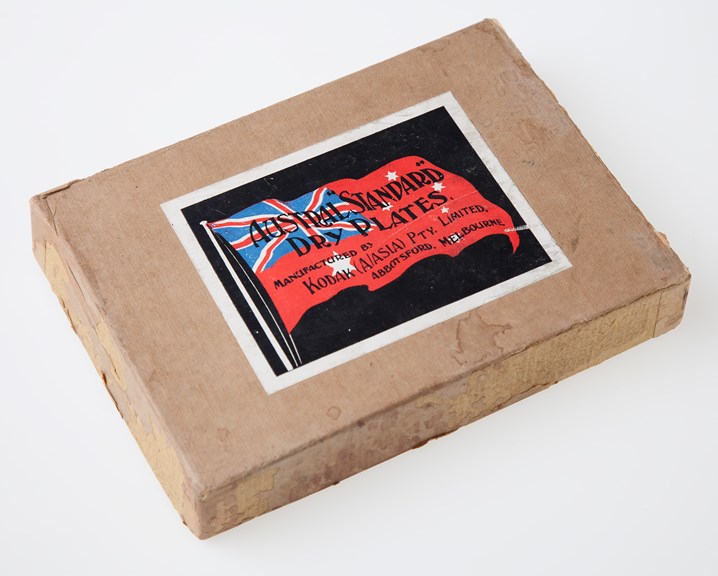Between 1884 and 2004, Kodak and its local predecessors manufactured and marketed photographic products to the Australasian region. This digital showcase provides a snapshot of that 120 year history, told through Museums Victoria's Kodak Heritage Collection.
Kodak Australasia's long history stretches back over 140 years to the 1880s. Discover the entrepreneurs who founded Kodak’s photographic manufacturing and marketing operations in Australia.
In 1908, 24 years after Thomas Baker made his first dry plates in his home cellar, the company he co-owned with JJ Rouse, known as Baker & Rouse Pty Ltd, merged with George Eastman‘s American based company, Eastman Kodak Company, to become Australian Kodak Limited.
"…a splendid opportunity of acquiring a practical monopoly of the whole Australian trade in films…" Letter from Thomas Baker to George Eastman, 14 August 1907, Eastman Museum.
In September 1907, photographic manufacturer Thomas Baker, along with his wife Alice and sister-in-law Eleanor Shaw, left Australia in a hurry.
They boarded a ship to America with only about a week’s notice and weren’t back in Australia for ten months.
Earlier on in the year, the Australian government had announced that it was going to introduce a new duty on sensitised photography goods and cameras.
The new duty, which gave an advantage to British goods, would potentially devastate Thomas Baker’s business, Baker & Rouse Pty Ltd, which he co-owned with JJ Rouse.
As sole agents of Kodak, Baker & Rouse Pty Ltd was contracted to mainly sell goods from Eastman Kodak in America. If the duty went through, Baker & Rouse would suffer “a great blow” and probably be unable to fulfil its terms of contract with Kodak.
It wasn’t all bad news though. The potential tariff also gave Baker & Rouse a unique opportunity to create a monopoly in the Australian photographic industry by becoming a local manufacturer for Kodak, which would avoid paying the duty.
Baker had written to George Eastman in August of that year, “… it has occurred to me that the circumstances give a splendid opportunity of acquiring a practical monopoly of the whole Australian trade in films and to a considerable extent in apparatus.”
“…the question arises whether you would be prepared to join with us in the manufacture of films here and perhaps eventually of many forms of cameras… The present opportunity of starting the manufacture with so heavy a protective duty is not likely to recur in our time.” Thomas Baker
MM 140939 – Eastman Kodak Company founder, George Eastman, circa 1920s.
Kodak already had an option to buy out Baker & Rouse, but Thomas Baker wanted to propose a merger instead. On behalf of JJ Rouse and himself, Thomas Baker, the senior director of Baker & Rouse, put plans in motion.
The Baker party set out on the first steamer to America they could secure tickets for, to urgently negotiate with George Eastman about the future of their business.
It was a successful journey.
In December 1907 a contract was settled on for the creation of a new business known as ‘Australian Kodak Limited’.
George Eastman had wanted a Kodak ‘house’ in Asia for some time, and Baker & Rouse wanted to continue their success in Australia, so the new arrangement suited both parties.
On 7 August 1908 the transfer of business officially took place. The manufacturing component of the Baker & Rouse Pty Ltd business was acquired by Eastman Kodak. The Baker & Rouse retail operations became a subsidiary of Australian Kodak Limited, but under the terms of the contract it could still trade under the name Baker & Rouse.
The new company would take over the Australian and NZ agencies of Kodak and have the sole right to use the Kodak brand name in those countries.
The capital for the new company was 150,000 pounds, issued in £1 shares. Eastman owned 50.1% and Baker & Rouse owned 49.9%. This deal made both Thomas Baker, the primary shareholder of Baker & Rouse, and JJ Rouse, and their families, wealthy.
HT 25775.8 – Australian Kodak Limited’s first book of Share Certificates, with certificate number 1 issued to chief managing director Thomas Baker, 26 April 1909.
TL 63609 – User Guide - Australian Kodak Limited, 'List Of
Velox And Chemical Preparations', Abbotsford, 1908-1911
As well as being shareholders, Thomas Baker & JJ Rouse were appointed as the founding directors. Thomas Baker oversaw the factory, while JJ Rouse was in charge of retail.
The new Australian Kodak Limited range was to include Kodak non-curling films, collodio-carbon paper, Aristo paper, Velox paper, Solio PO paper, and ferro-prussiate paper, in addition to a new brand of dry plates.
Thomas Baker and his party travelled to and fro between America, England and Europe for the six months following the negotiations at Kodak headquarters in Rochester. Baker was busy, arranging design plans and equipment for a new factory building to make Kodak products. This was going to be built at the original Baker & Rouse Austral Works in Abbotsford, at the cost of £25,000.
Ten months after they hastily had left Australia, Thomas and Alice Baker and Eleanor Shaw finally returned home. They returned as Kodak shareholders – their lives and those of JJ Rouse and family, and the local photographic industry, transformed forever.
Kodak (Australasia) Limited [1911-1920]
At two extraordinary general meetings at the registered Australian Kodak office in Bond Street, Abbotsford in September 1910, it was agreed that Baker & Rouse Pty Ltd would be wound up. Kodak company secretary John Sutherland was appointed liquidator.
HT 23456 – Portrait of John Sutherland, was company
secretary, and later a company director, circa 1930s.
The notion of closing Baker & Rouse had been entertained by Thomas Baker as soon as twelve months after Australian Kodak Limited was formed. Baker wrote to George Eastman of Eastman Kodak, telling him that liquidating the company would save paying double income tax, and provide other benefits.
Eastman Kodak had also not been happy with the way that Baker & Rouse was trading and wanted to bring all the distributed retail branches under the Kodak umbrella.
At the same time, it was suggested by JJ Rouse that the company name be changed to acknowledge the Australasian reach of the business, in particular its presence in New Zealand, where a branch had opened in 1909.
Thus, in 1911 the Australian Kodak Limited company structure was changed to be fully Kodak operated, with the retail branches now branded as Kodak. To legally manage these changes, a new company was formed.
The new company was known as Kodak (Australasia) Limited.
Baker & Rouse still held considerable currency in Australia, however, and it took some branches time to change over their shopfront branding.
Kodak Australasia Limited Shop in Argent Street, Broken Hill, 1912.
In 1920, Kodak became a proprietary limited company. This was the final change of name for the Australian subsidiary of Kodak.
However, a new addition to the Australasian Kodak family was made in 1931 when Kodak (New Zealand) Limited was formed. The managing director of Kodak Australasia Pty Ltd was responsible for the New Zealand operations.
Over coming decades Kodak Australasia underwent significant changes when Thomas Baker died in 1928, followed by JJ Rouse in 1938. JJ Rouse’s son Edgar subsequently became managing director and then chairman of the board.
When Edgar Rouse retired in 1959 it marked the end of half a century of Kodak leadership from Baker and the Rouses. It also signalled a shift away from the family led business towards a more corporate operation.
Two other key changes occurred that shaped the future of Kodak Australasia Pty Ltd. The first was when a new factory was finally opened, at Coburg, in 1961 – while the second was when this factory was closed down in 2004.
The transformation of photography by digital technology decimated Kodak’s worldwide profits and resulted in manufacturing plants around the world closing, with Melbourne’s factory being an early casualty.
Although manufacturing no longer happens in Australia, Kodak Australasia Pty Ltd continues to trade in the 21st century. It distributes imported photographic equipment and supplies throughout Australia, as the company always has - including now digital cameras.
Museums Victoria Kodak Collection
References
Advocate, 4 July 1908, p.39
Age, 19 Sep 1908, p.13
Ancestry, Year: 1908; Arrival: New York, New York, USA; Microfilm Serial: T715, 1897-1957; Line: 9; Page Number: 8; Ancestry.com. New York, Passenger and Crew Lists (including Castle Garden and Ellis Island), 1820-1957 [database on-line]. Provo, UT, USA: Ancestry.com Operations, Inc., 2010
Argus, 31 March 1908. p.4; 19 Sep 1908, p.14
Australasian Photo-Review, 21 September 1908, p.331; 15 November 1930, p.532
George Eastman Museum, Correspondence - Thomas Baker to George Eastman, 2 Sep 1907; 14 August 1907; 22 May 1908; 31 July 1909; 17 August 1910; 1 Oct 1918
Museums Victoria Kodak Collection, HT 25783.3, Balance Sheets - Kodak Archive, Series 12, Australian Kodak Ltd & Baker & Rouse, 31 May 1908; The History of Kodak in Australia, Nigel Beale (unpublished, 1983)
University of Rochester, Kodak Historical Collection #003, Series II, Corporate papers National & International, Subseries 10: National and International Kodak Locations, Box 59: Annual Reports and Data, Folder 9: Information on Foreign Companies (File 1 of 3), Report
Victorian Gazette, Thomas Baker, 12 October 1910, p.4743; JS Sutherland, 13 December 1911 p.5960

